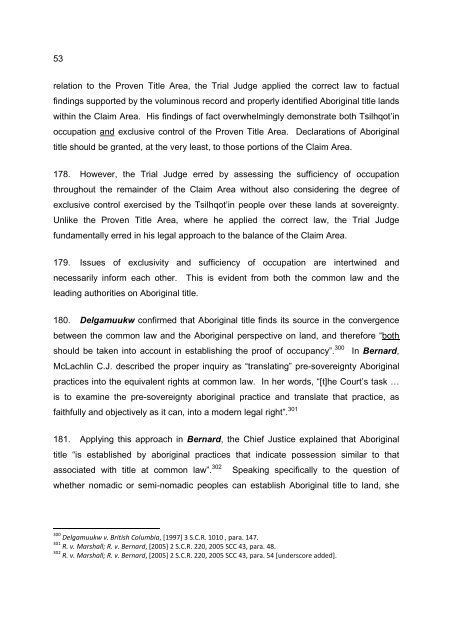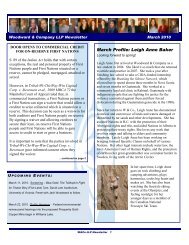Appellants factum - Woodward & Company
Appellants factum - Woodward & Company
Appellants factum - Woodward & Company
You also want an ePaper? Increase the reach of your titles
YUMPU automatically turns print PDFs into web optimized ePapers that Google loves.
53relation to the Proven Title Area, the Trial Judge applied the correct law to factualfindings supported by the voluminous record and properly identified Aboriginal title landswithin the Claim Area. His findings of fact overwhelmingly demonstrate both Tsilhqot’inoccupation and exclusive control of the Proven Title Area. Declarations of Aboriginaltitle should be granted, at the very least, to those portions of the Claim Area.178. However, the Trial Judge erred by assessing the sufficiency of occupationthroughout the remainder of the Claim Area without also considering the degree ofexclusive control exercised by the Tsilhqot’in people over these lands at sovereignty.Unlike the Proven Title Area, where he applied the correct law, the Trial Judgefundamentally erred in his legal approach to the balance of the Claim Area.179. Issues of exclusivity and sufficiency of occupation are intertwined andnecessarily inform each other. This is evident from both the common law and theleading authorities on Aboriginal title.180. Delgamuukw confirmed that Aboriginal title finds its source in the convergencebetween the common law and the Aboriginal perspective on land, and therefore “bothshould be taken into account in establishing the proof of occupancy”. 300 In Bernard,McLachlin C.J. described the proper inquiry as “translating” pre-sovereignty Aboriginalpractices into the equivalent rights at common law. In her words, “[t]he Court’s task …is to examine the pre-sovereignty aboriginal practice and translate that practice, asfaithfully and objectively as it can, into a modern legal right”. 301181. Applying this approach in Bernard, the Chief Justice explained that Aboriginaltitle “is established by aboriginal practices that indicate possession similar to thatassociated with title at common law”. 302 Speaking specifically to the question ofwhether nomadic or semi-nomadic peoples can establish Aboriginal title to land, she300 Delgamuukw v. British Columbia, [1997] 3 S.C.R. 1010 , para. 147.301 R. v. Marshall; R. v. Bernard, [2005] 2 S.C.R. 220, 2005 SCC 43, para. 48.302 R. v. Marshall; R. v. Bernard, [2005] 2 S.C.R. 220, 2005 SCC 43, para. 54 [underscore added].



